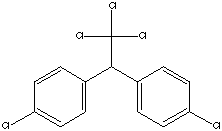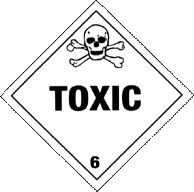DDT
- 2,2-bis(p-Chlorophenyl)-1,1,1-trichloroethane
- Dichlorodiphenyltrichloroethane
- 1,1,1-Trichloro-2,2-bis(p-chlorophenyl)ethane
- Clofenotane

DDT | |
| |
| Formula | C14H9Cl5 |
| Structure |  |
| Description | A colorless crystalline solid or white to off-white powder. Odorless to slightly aromatic. |
| Uses | Acaricide, insecticide. |
| Registry Numbers and Inventories. | |
| CAS | 50-29-3 |
| EC (EINECS/ELINCS) | 200-024-3 |
| EC Index Number | 602-045-00-7 |
| EC Class | Toxic; Carcinogenic Category 3; Dangerous for the Environment |
| RTECS | KJ3325000 |
| RTECS class | Agricultural Chemical and Pesticide; Tumorigen; Mutagen; Reproductive Effector; Human Data |
| UN (DOT) | 2761 |
| Merck | 12,2898 |
| Beilstein/Gmelin | 1882657 |
| Beilstein Reference | 4-05-00-01885 |
| RCRA | U061 |
| EPA OPP | 29201 |
| Swiss Giftliste 1 | G-1529 |
| Canada DSL/NDSL | DSL |
| US TSCA | Listed |
| Austrailia AICS | Listed |
| Japan ENCS (MITI) | Listed |
| Properties. | |
| Formula | C14H9Cl5 |
| Formula mass | 354.49 |
| Boiling point, °C | 260 |
| Vapor pressure, mmHg | 0.0000002 |
| Vapor density (air=1) | N/R |
| Density | 1.5 g/cm3 |
| Solubility in water | Insoluble |
| Refractive index | 1.5795 (110 C) |
| Partition coefficient, pKow | 6.91 |
| Heat of vaporization | 83.74 kJ/mol |
| Hazards and Protection. | |
| Storage | Keep in well ventilated area. |
| Handling | All chemicals should be considered hazardous. Avoid direct physical contact. Use appropriate, approved safety equipment. Untrained individuals should not handle this chemical or its container. Handling should occur in a chemical fume hood. |
| Protection | Wear appropriate protective gloves, clothing and goggles. |
| Respirators | Wear positive pressure self-contained breathing apparatus (SCBA). |
| Small spills/leaks | Do not touch damaged containers or spilled material unless wearing appropriate protective clothing. Stop leak if you can do it without risk. Prevent entry into waterways, sewers, basements or confined areas. Cover with plastic sheet to prevent spreading. Absorb or cover with dry earth, sand or other non-combustible material and transfer to containers. DO NOT GET WATER INSIDE CONTAINERS. |
| Stability | Stable. |
| Incompatibilities | Incompatible with strong oxidizing and reducing agents Incompatible with many amines, nitrides, azo/diazo compounds, alkali metals, and epoxides Incompatible with alkaline media. |
| Decomposition | Decomposition at 110 C; dehydrochlorinates in alkali or organic bases when in organic solvents. |
| Fire. | ||||
| Flash Point,°C | 162-171 | |||
| Fire fighting | Fire Extinguishing Agents: Water, foam, dry chemical, or carbon dioxide | |||
| Fire potential | Nonflammable. | |||
| Combustion products | Toxic and irritating gases may be generated Melts and burns | |||
| Health. | |
| Exposure limit(s) | TLV: ppm; 1 mg/m3 (as TWA) (ACGIH 1993-1994). OSHA PEL: TWA 1 mg/m3 skin NIOSH REL: Ca TWA 0.5 mg/m3 See Appendix A NIOSH IDLH: Potential occupational carcinogen 500 mg/m3 |
| Carcinogin | G-A3, I-2B, N-2, CP65 |
| Poison_Class | 3 |
| Exposure effects | CNS excitation, seizures, tremor, ataxia, agitation, nervousness, and amnesia may occur. Kelthane, perthane, methoxychlor, and hexachlorobenzene have little CNS toxicity; in extreme overdose CNS depression may occur. Organochlorine pesticides such as DDT pass through the placenta, with an average level in the newborn blood reaching around a third of that in maternal blood. They can also be found in breast milk. Excessive absorption of kepone (chlordecone) has depressed sperm counts and sperm motility in exposed workers. |
| Ingestion | Nausea, vomiting, and diarrhea may follow ingestion. |
| Inhalation | Aspiration of insecticide containing petroleum distillate may result in pneumonitis. |
| Skin | Extensive contact results in dermal irritation. |
| Eyes | See Inhalation. |
First aid |
|
| Ingestion | If the victim is conscious and not convulsing, give 1 or 2 glasses of water to dilute the chemical and IMMEDIATELY call a hospital or poison control center. MMEDIATELY transport the victim to a hospital. |
| Inhalation | IMMEDIATELY leave the contaminated area; take deep breaths of fresh air. IMMEDIATELY call a physician and be prepared to transport the victim to a hospital even if no symptoms (such as wheezing, coughing, shortness of breath, or burning in the mouth, throat, or chest) develop. Provide proper respiratory protection to rescuers entering an unknown atmosphere. Whenever possible, Self-Contained Breathing Apparatus (SCBA) should be used. |
| Skin | IMMEDIATELY flood affected skin with water while removing and isolating all contaminated clothing. Gently wash all affected skin areas thoroughly with soap and water. If symptoms such as redness or irritation develop, IMMEDIATELY call a physician and be prepared to transport the victim to a hospital for treatment. |
| Eyes | First check the victim for contact lenses and remove if present. Flush victim's eyes with water or normal saline solution for 20 to 30 minutes while simultaneously calling a hospital or poison control center. Do not put any ointments, oils, or medication in the victim's eyes without specific instructions from a physician. IMMEDIATELY transport the victim after flushing eyes to a hospital even if no symptoms (such as redness or irritation) develop. |
| Transport. | ||
| UN number | 2761 |  |
| Response guide | 151 | |
| Hazard class | 6.1 | |
| Packing Group | I; II; III | |
| USCG CHRIS Code | DDT | |